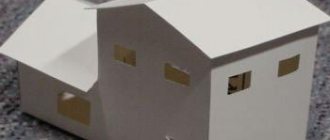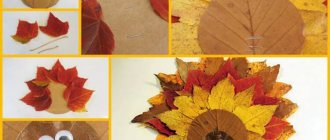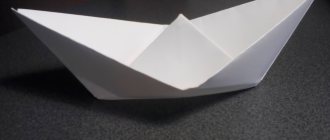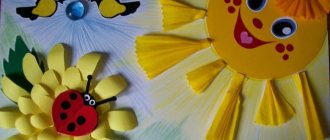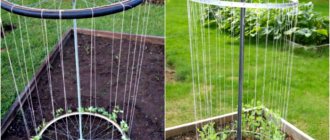Do-it-yourself Farm layout
Olga Atavina
DIY “Farm” layout
I have long wanted to make a toy farm with pets for group lessons and individual play for children. The main goal was to introduce children to domestic animals and their young, to teach them to name and compare them by size; develop curiosity, memory, attention, speech; as well as enrich children’s vocabulary and cultivate a love for animals. Using a similar layout , I want to implement the following tasks in the first junior group:
- teach children to distinguish by appearance and name the most common domestic animals;
- develop speech, thinking, memory, attention, observation;
— to cultivate a love for pets, their importance in a person’s life, and curiosity.
And I was inspired by ideas from the Internet - most of the options were very interesting. As a basis, I took ready-made models of a house, a mill, a chicken coop, and a dog house made of plywood, which were sold in an online store. This is how our own farm , made with our own hands . The base for the layout was made of thin plywood and painted with acrylic paint. I also painted the house and the mill with colored acrylic. The duck pond is made from hot melt glue applied to blue cardstock. The edges of the pond are sprinkled with sea sand brought from vacation. Making such a farm is not so difficult , try it - you will succeed!
DIY aquarium model for a corner of nature I didn’t have an aquarium in my group, and I wanted to make such a surprise for my students. Goal: to clarify children’s ideas about what. Do-it-yourself busy board A child who learns about the world around him strives to touch and try everything. To give them the opportunity to play with all sorts of things to their heart's content. Do-it-yourself busy board The child enjoys exploring the world around him. He is interested not only in toys, but also in all objects around that may pose a danger: DIY games Hello, SUMMER! So much sun! How much light! So much greenery all around! What is this? This SUMMER is finally rushing into our house. There is a diversity of songbirds. Do-it-yourself “Farm” model for a story game in a preschool organization “Farm” model for a story game in a preschool organization. In order to make a model, you will need: a box, medical spatulas, pieces. DIY fire shield model for a kindergarten. My daughter and I created this model to decorate a fire safety corner in our favorite kindergarten. I think the material will be useful to teachers. Layout “Do-it-yourself fire shield” A fire is always an unexpected, extreme situation in which a feeling of fear appears in any person. Therefore, psychological is very important.Master class for teachers “Do-it-yourself model of the planet Earth” To familiarize children with the world around them, in particular with the planet Earth on which we live, a do-it-yourself model of the Earth will help.
Master class “Do-it-yourself layout of traffic rules” The layout is intended both for direct educational activities and for independent activities of children. This guide is possible.
DIY frame DIY frame. Objectives: Educational objectives: to expand students’ knowledge about the variety of crafts made from waste material; introduce the species.
Source
What building materials and tools are needed?
First of all, it is necessary to decide what building materials to use for the construction of the barn, since this determines: how quickly the construction will take place, how reliable and durable the structure will be, and how comfortable the animals will be in it.
Buildings in the construction of which concrete was used did not justify their worth, since they have increased thermal conductivity. During the summer months, it is very hot in such a barn, and during the cold season the heat does not stay inside the building. The use of wood is more expedient, since this material has low thermal conductivity. Although there are some disadvantages: the material is fragile, fire hazardous, the boards can rot, and their cost is quite high.
Brick is successfully used in the construction of mini-farms. This building material is capable of excellent heat retention and excellent protection from outside noise.
It is not advisable to use bricks for the construction of a large complex for keeping cows. In this case, it is better to use modern SIP panels (sandwich panels consisting of slabs with insulation between them). This building material is characterized by quick construction, relatively low cost, and excellent thermal insulation.
DIY farm model made from paper tubes and cardboard
Tatyana Shekhovtsova
DIY farm model made from paper tubes and cardboard
This master class is for teachers and parents.
Purpose: for group lessons and individual play for preschool children.
Goal: to introduce children to domestic animals and their babies, to teach them to name and compare them by size; develop curiosity, memory, attention, speech; enrich vocabulary; develop a love for animals
- teach children to distinguish by appearance and name the most common domestic animals;
How to keep livestock using the tether method
The economic farmer takes care of his livestock. If you use the untethered method in a hangar, then the building should:
- connect to the water supply and electrical network;
- maintain special equipment that monitors the well-being of animals and the indoor microclimate;
- be with an area of at least 1000 m²;
- the height of the room must be above 6 m;
- for 50 cows, the size of the hangar should be 15x70 m.
Important! It is worth considering which products will predominate: dairy or meat. With the free-stall method of obtaining milk, when cows have free access to the feeder and can also walk, milking is done in a special room
The main technology for collecting milk is carried out in:
With the free-stall method of obtaining milk, when cows have free access to the feeder and can also walk, milking is done in a special room. The main technology for collecting milk is carried out in:
- boxing;
- combibox;
- on deep litter that does not change.
The advantages include:
- high efficiency;
- improved working conditions;
- good handling of livestock.
Of the minuses:
- animals become just a herd, without nicknames;
- they fight for food and water;
- the amount of feed consumed increases;
- Additional requirements apply to animals.
Additional Information! A dedicated milking parlor uses either a herringbone or tandem approach. The length of the milk pipeline is reduced by 5 times, which improves the quality of the dairy product and also provides the required sanitary care.
To keep cows free-stall, the following conditions must be met:
- ensure separate maintenance of livestock;
- eliminate the disorderly movement of milked and unmilked cows;
- ensure the passage of milked animals to the paddock or to the feeding trough.
This method guarantees an increase in milk yield and faster weight gain for animals. The cattle stands in its own compartment, which has an area of up to 2.5 m². Here she lies, relieves her natural needs, and has access to a feeding trough. Almost all large farms use this method.
The disadvantage is the need to increase the labor force to feed the animals, clean up after them, as well as veterinarians to monitor the health of the animal, since chronic diseases develop in sedentary cattle.
Pros:
- animals do not collide and are not injured;
- each animal receives as much feed as it needs, the stronger animal does not eat the weaker;
- feed consumption is reduced by 10%, which is beneficial for the farmer;
- It is easier for veterinarians to monitor each animal;
- the cow produces 20% more milk, and the calf gains weight 15% faster;
- milking cows is easier.
Note! If you build stalls in a barn correctly, urine and manure will flow outside the barn. There is a standard way of milking in a special milking parlor
In this case, the cows have an automatic tether, but it can also be semi-automatic. This doubles the productivity of milk production
There is a standard way of milking in a special milking parlor. In this case, the cows have an automatic tether, but it can also be semi-automatic. This doubles the productivity of milk production.
Note! In addition, the cows pass through the wash, which ensures the purity of the product.
Master class on making a “Pet Farm” model
Ekaterina Saenko
Master class on making a “Pet Farm” model
Dear colleagues! I bring to your attention a master class on making a model from plywood “ Farm ”.
I want to warn you right away that our pupil’s grandfather made us a house, a corral for horses and a fence. For which I thank him very much! I just gave these amazing buildings an aesthetic appearance. Look what I got.
To make the layout we will need:
-Glue (PVA, Liquid nails, “Titan”)
;
-Newspaper, white paper, napkins;
-Blue fabric;
-Felt (white, green, yellow)
;
-Pet figurines ;
So, first I painted the house and the horse pen, which were made in advance, with gouache and varnished them.
Then these models (house, paddock)
I glued it to the plywood with Titan glue.
Let's start making trees . I used the papier-mâché technique. I drew stencils of trees on thick cardboard and cut them out.
Next, we cover our tree frame with newspaper, white paper and napkins using PVA glue. I waited until it was completely dry and started painting the trees, then I glued the leaves made with a stencil hole punch to the crown of the trees and coated them with varnish.
Equipment and interior design
It is important not only to build a barn correctly, but also to carefully consider its internal arrangement (Figure 4). To maintain livestock productivity, you need to draw up a plan for the location of animals in advance so that there is enough space for the entire livestock
In addition, the interior of the building must be properly treated to prevent animals from suffering from mold, mildew, or drafts.
If we talk about the general rules for the internal arrangement of a barn for 50 heads, then the main nuances will be as follows:
- The size of the stall for one adult should be 1.7 * 1.1 meters. However, if you plan to keep cows with calves, the area of one compartment needs to be increased.
- It is better to make the floor wooden, since the concrete surface is too cold and can cause colds in cows. It is advisable to use sawdust or straw as bedding, and this covering should be changed regularly as it gets wet.
- A chute is installed at the rear of each stall to drain slurry. It should be built in such a way that the gutter has a slight slope towards the collector or cesspool. This will make your work easier, since the waste products of livestock will gradually flow into the pit. At the point where the chute exits the barn, a small opening is made in the wall and covered with a valve.
- In the front part of the stall there is a feeder and a drinker. The simplest model of a feeder is a trough with sides. Such a product can be easily made with your own hands from planed and sanded boards.
- If you plan to keep cows and calves together, next to each stall you need to build a small compartment or cage in which the young animals will be kept.
Compliance of the internal space with sanitary and hygienic standards also plays an important role in maintaining the health and productivity of cattle. The problem is that pathogenic microorganisms actively develop in the barn environment. To prevent this, you need to regularly clean the premises, remove residual manure from gutters and change the litter. In addition, immediately after the construction of the building, it is necessary to plaster the internal walls and whitewash them with lime. This substance has antibacterial properties and prevents the development of fungi and mold inside the barn.
Business plan (to build a good wooden or frame barn, costs for young animals, feed)
The cost of maintaining and raising cows for meat is determined by many parameters. This is the area of the territory, the number of livestock, materials for the construction of the barn and the costs of feeding and servicing the animals. At the beginning, significant costs will always be required, which will begin to pay off only after several calvings, since proceeds from the sale of dairy products can only partially cover the costs of maintaining cattle.
Read the business plan for cattle breeding here.
Costs for the workover device
Setting up a farm and purchasing the first livestock of animals and feed for them requires significant financial investments. The primary costs for organizing a cattle breeding business are:
- Land lease . The price directly depends on the area. In fertile areas with a mild climate, the cost of rent for farming needs is always higher. It is advisable to acquire the necessary space over time, which will significantly reduce costs. To raise 100 heads of livestock, at least 1 hectare of territory is required.
- Construction and equipment of a cowshed . This is one of the largest expenses at the beginning of production. It is profitable to build a shed on your own without hiring third-party workers. The cost of construction depends on the area of the barn and the automation of the process. Most often they resort to modern prefabricated standard barn layouts, where all the necessary communications are connected: water supply, electricity, sewerage, ventilation, etc.
- Purchase of animals . Initially, it is advisable to purchase several adult cows and bulls, as well as 10-12 heads of young animals. You should not immediately buy purebred and breeding animals, since most often they require special maintenance;
- Purchase of feed . It is purchased based on the number of livestock, the season of the year, and also taking into account the required feed. In summer, food costs are lower, since grazing is possible. In addition, you should immediately purchase all vitamins and feed additives;
- Hiring workers and paying wages . Self-maintenance of a farm with more than 15 cows is physically impossible. Therefore, it is necessary to hire employees to clean the premises, care for animals and collect products. The cost of veterinary care must also be included in the estimate.
Read about the feeding diet for dairy cows here.
The costs of setting up a business vary greatly depending on the location. In the southern and eastern regions, raising cows is cheaper, but it is important to understand that there is more competition in the market in these areas.
Profitability
Raising cattle is a profitable business, but this condition applies only to large farms with established sales channels. In the early stages, you will need to invest at least 1 million rubles for the arrangement of premises, the purchase of animals and feed. On average, the farm's payback period occurs no earlier than in 1.5-2 years, provided that meat and milk are constantly sold and new animals are purchased. Profitability largely depends on the productivity and health of livestock. If you create the right conditions, you can subsequently receive a stable income from the sale of replacement young stock, especially when raising productive breeds of cattle.
Read about keeping a cow on a private farm here.
Calculation of the area and diagram of the barn by the number of heads
The size of the barn is determined by the number of livestock, the way the animals are kept, and the need for utility rooms. The approximate area of the barn with your own hands should be calculated depending on the number of heads. Initially, a drawing is created for a standard barn, on the basis of which a step-by-step design of the future layout begins in accordance with European standards for keeping animals.
During the planning stage, it is important to consider the use of every square meter in order to maximize the limited area.
The area of the barn directly depends on the volume of livestock, as well as the number of rows in the room. For small farms, the optimal area for 1 head is 10 m2, and for large farms it is about 6 m2. The stalls are always organized in a row manner. The maximum number of cows in one row is 50. The table shows the approximate dimensions of the barn for different numbers of cattle.
| Livestock | Area, m2 | Number of rows |
| 10 | 100 | 1 |
| 20 | 200 | 1 |
| 30 | 300 | 1 |
| 50 | 500 | 1-2 |
| 100 | 800 | 2-4 |
| 200 | 1200 | 6-8 |
| 300 | 1800 | 6-8 |
| 500 | 3000-4000 | 8-10 |
| 1000 | 6000-8000 | 8-10 |
Designing an area according to Euronorm dimensions
The barn is traditionally shaped like a rectangle or square, which increases the capacity of the building. The height of the room should be at least 2.2-2.5 m, but when using an attic the size increases. Each animal requires at least 6 m2, and a cow and calf require 12 m2. In practice, the pasture-stall housing method is most often used, so it is necessary to provide space in the barn for each cow. The average size of a barn is 100 m2; this area allows for the expansion of the animal population, as well as accommodating all the necessary outbuildings.
Tools and materials
Before building a farm, you need to stock up on the necessary tools and materials. To work you will need:
- dry concrete mixture or cement and sand;
- brick, wood or blocks;
- slate;
- roofing felt;
- insulation;
- fasteners;
- beams and/or beams.
The set of tools must include:
- shovels - shovel and bayonet;
- construction tape;
- plumb and level;
- technical knife;
- hammer drill or electric drill;
- construction mixer or concrete mixer;
- containers for solution;
- saw and/or hacksaw;
- mason's tool;
- wire cutters and/or pliers;
- hammers and sledgehammers;
- workwear;
- rags.
To store supplies of materials and working tools, you can set up a small barracks or a fenced area with a canopy.
